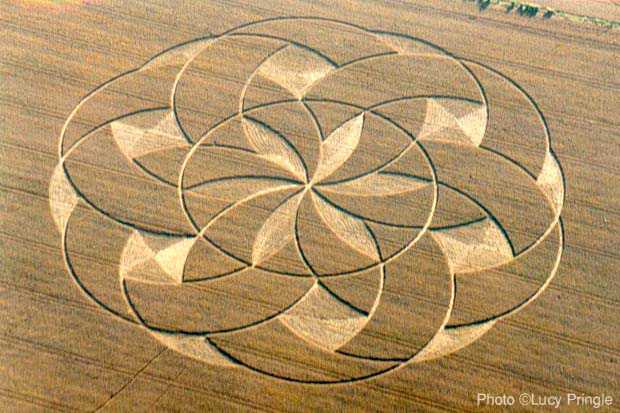
text and diagram copyright Jonah Ohayv, Jan. 2004
Often, the argument follows that all this preliminary, necessary "drawing" in the mature grain-field itself will show up as pathways, where downlaid crop can't have sections lifted again or "erased". Formations in which these parts of pathways are in fact missing are assumed to be thereby proven genuine.
In modern practice, however, these preliminary drawings can be made on a computer or even on paper, lines measured and parts of them erased, the preferred angles and distances kept simple, or computed and measured.
The question is then:
Can the finished drawing be practically reproduced in a field step by step, using pre-measured knotted strings or luminescently pre-marked tape measures, bamboo poles if necessary (filling in obvious holes afterwards), and by repetitively making equal arcs or lines from one point to the next needed one?
Whenever the order of steps in the field can practically proceed so that the finishing point of step one is the start for step two, which again repetitively continues around the formation, and when one or two pre-made markings or knots are the only measurements needed, one can vastly simplify the theoretical pre-made result in the actual crop-flattening process.
If the thus marked main distance and its halving or doubling are compatible with the standard width between the field's tramlines, the field's own lines could also often be used as background graph-lines during the laying out. Or if the final distances are in simple, whole numbers of British feet, we can ask who would most likely use this - hoaxers or the genuine energy?


Compare this to the formal construction-method in, for example, the article: "Reconstruction of the Nursteed 11-08-2002 formation" at http://www.zefdamen.nl/CropCircles/Reconstructions/2002/Nursteed02/nursteed2002en.htm . Elsewhere Zef clearly states that his "reconstructions are not meant to find out how crop circles are created in the fields", but are "made to better understand the design of the pattern".
There can be those that look like large or small "botched mistakes", for example when someplace is flattened while all its similar counterparts are standing, creating a visually irritating final product (I didn't visit the above sample formation, but see none of these in the photo).
Then there may be "nicety irregularites", which are geometrically unnecesary for the basic construction, are time-consuming, and which would often be only subliminally noticed in photos. (The one example I find above is the skewered, knotted meeting at the center of the diamond-like sections STEJ etc.)
There can be "too-detailed irregularities", as where mixed into the main lay, every second little group of straws points one way, but every third points another, adding extra harmony. Or regular junctions of neatly interweaving straws from several directions.
Or artistic, at-first "invisible irregularities", like layers of downed crop, each laid in other but consistent directions, underneath the visible, upper surface-lay.
Also there can be "mathematical irregularities", where difficult, non-whole proportions are used, such as in logarithmic curves, which really do require complicated measurements in the formation field, beyond the feasability of any fast construction-method.
Then again, there can be "two-dimensional impossibilities", such as large rings in standing, mature, brittle crop with no path leading to their center.
Those are weighty arguments for genuineness based on geometrical construction.